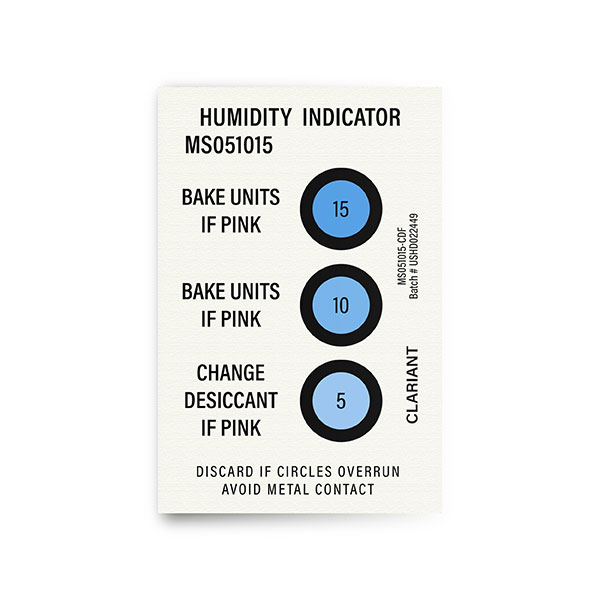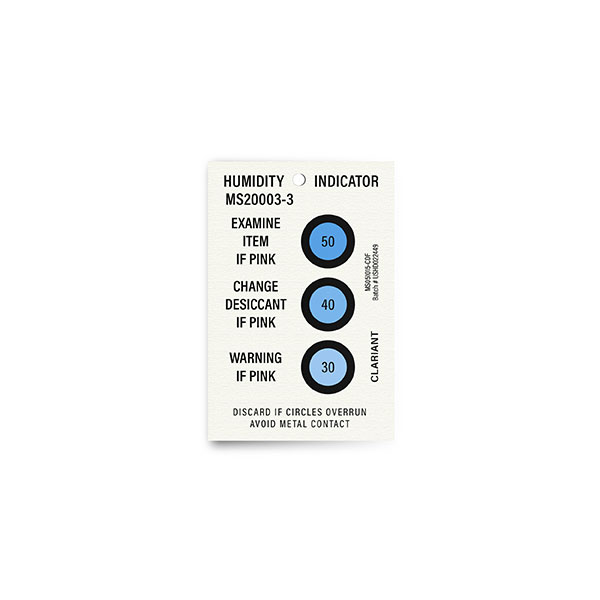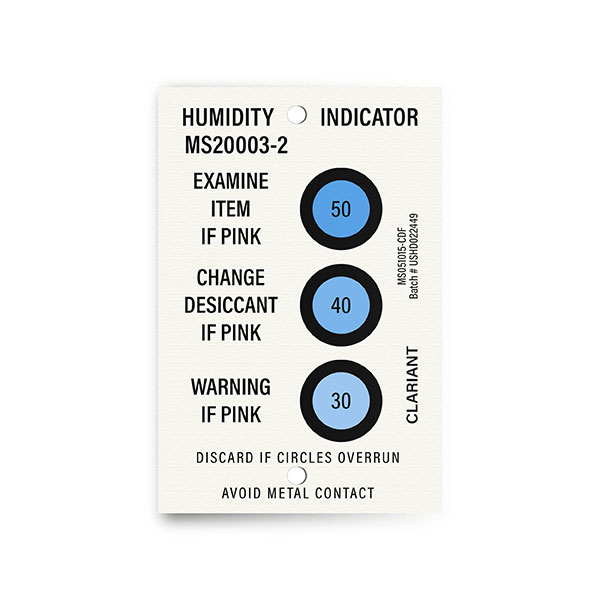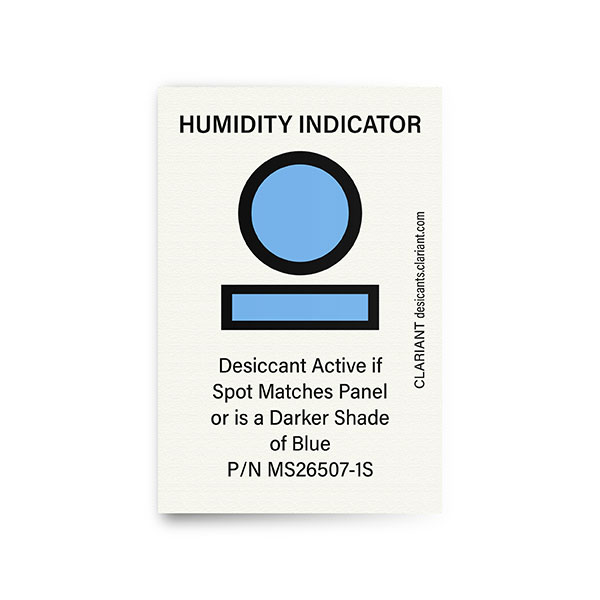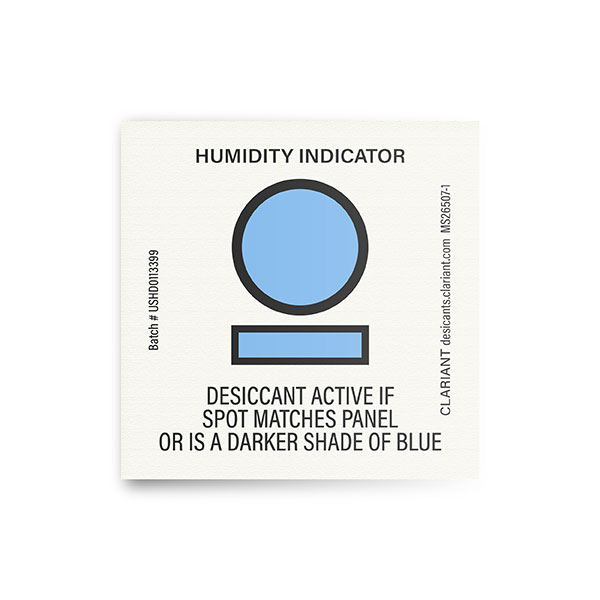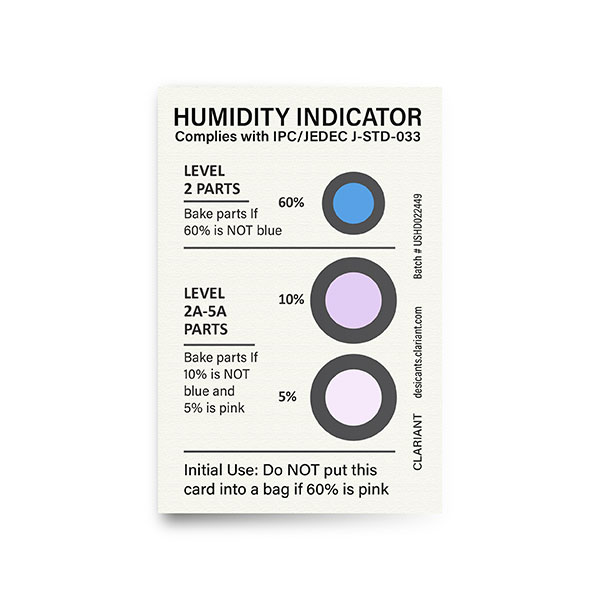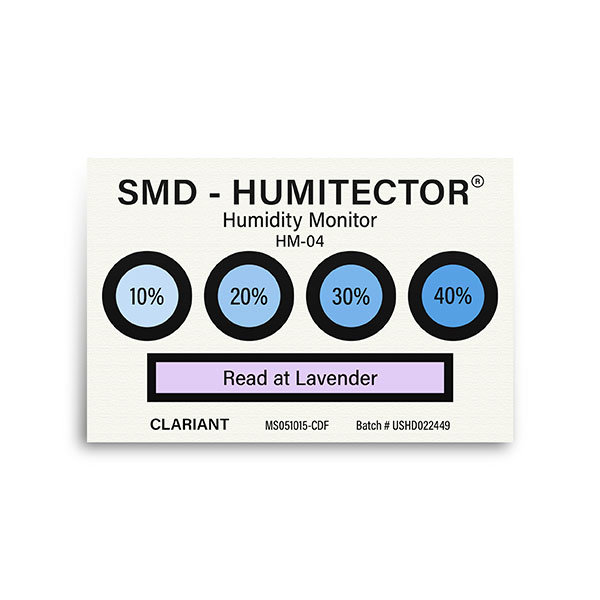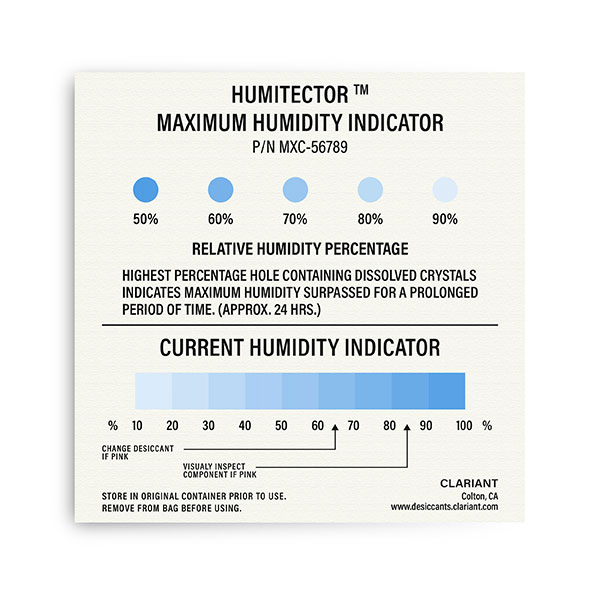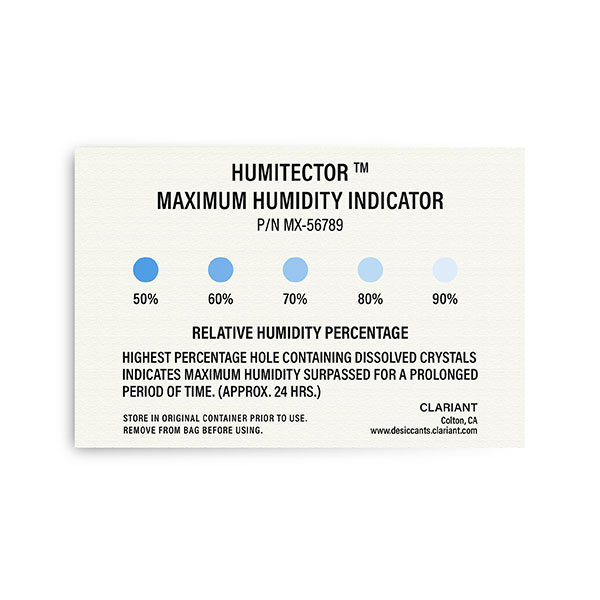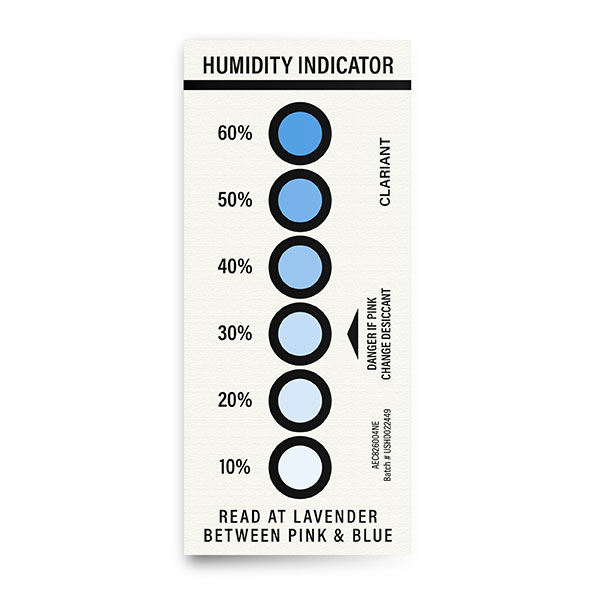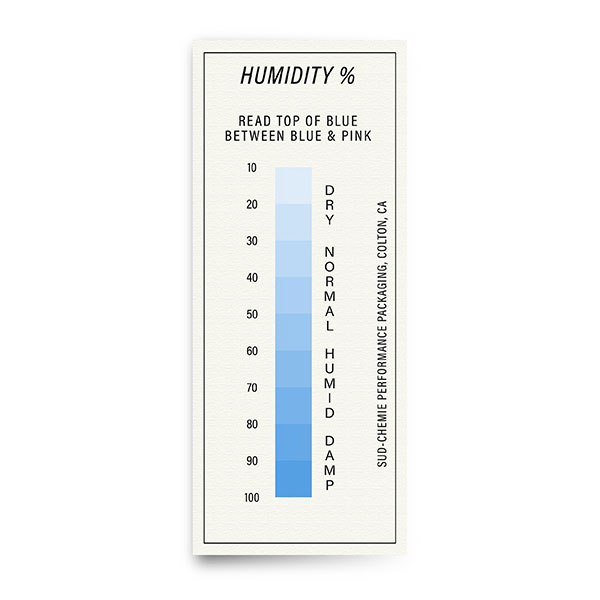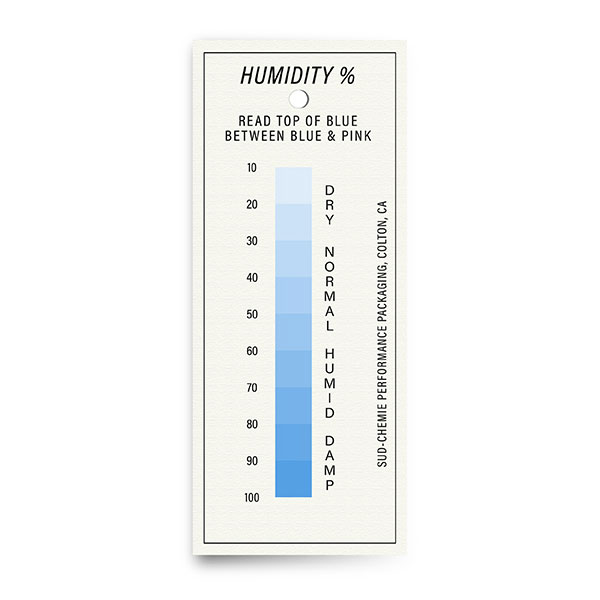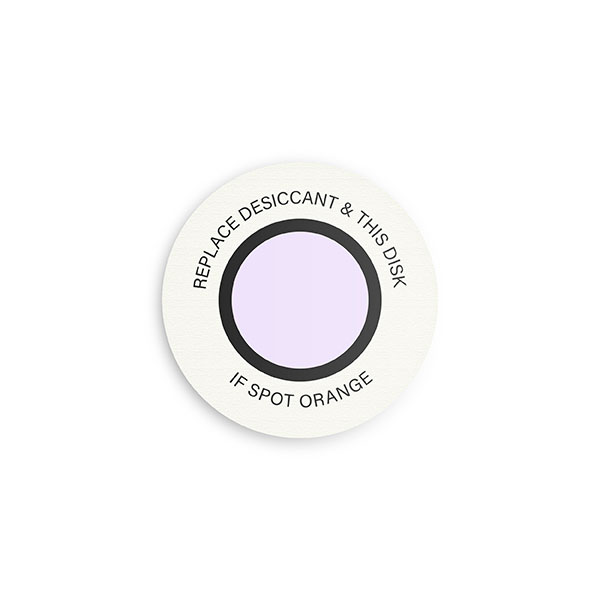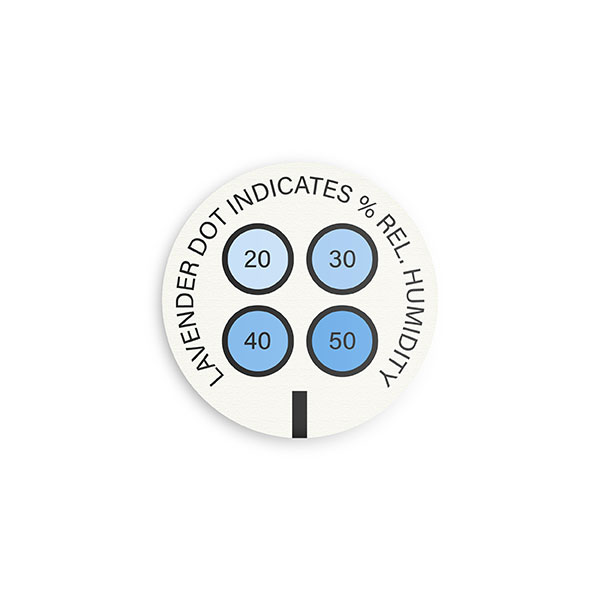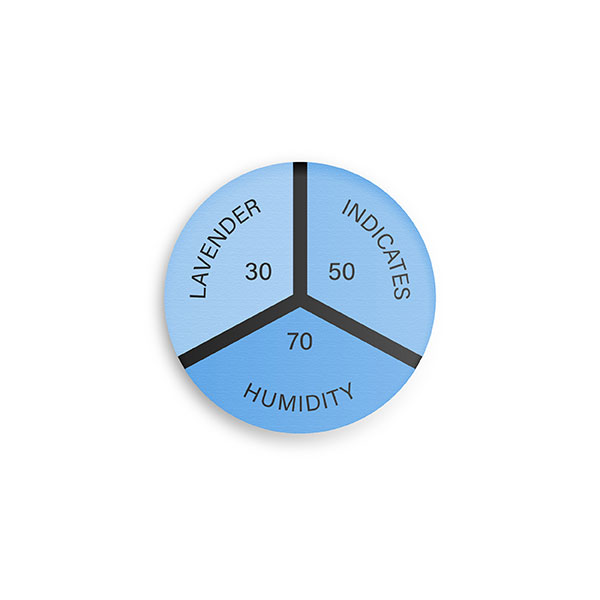Trouble finding a product?
Contact us.
Humidity Indicator Cards
Humidity indicator cards and sensors provide external monitoring of humidity levels inside containers and packages.
- Container Access
- Corrosion Prevention
- Humidity Monitoring
- Moisture Control
- Moisture Purging
- Pressure Control
- Shelving & Straps
- Shock Monitoring
Find What You're Looking For
It’s a lot, we know. If you’re looking for something specific or aren’t sure what you need, try searching through all products or give us a shout and we’ll help!
What are humidity indicator cards?
Humidity indicator cards provide external monitoring of humidity levels inside containers and packages.
A humidity indicator card is commonly made from blotter paper and can range in size from the size of a quarter to the size of a business card. The paper is treated with chemicals that react to varying levels of relative humidity by changing color.
How do humidity indicator cards work?
The reversible color-change discs are intended to serve as visual indicators that a given humidity level specified on the disc has been exceeded. This color-change element turns from blue to lavender to pink as the humidity increases and turns back to blue when the humidity decreases.
This characteristic enables these elements to be reused as long as they have not been exposed to humidity in excess of 90% for periods of 36 hours or longer, which tends to wash out the element. Such conditions are not uncommon in non-desiccated empty containers during periods of storage.
These chemically impregnated discs are made from blotting paper and are manufactured in accordance with MIL-I-8835. Humidity Indicator discs may be ordered pre-installed as a complete humidity indicator assembly (please refer to our Humidity Indicator Plugs) or may be installed in any SAE AS26860 type plug.
The color-changing element has long-term calibration and accuracy to within ±5% when read at 75°F (24°C). At other temperatures, a small correction factor of 2-1/2% for each 10°F (5.5°C) higher or lower than 75° must be taken into consideration. For example, at high temperatures, the element will indicate a lower humidity than is actually the case, and conversely, higher humidity will be indicated at low temperatures.
As indicated above, these elements are water-soluble and should not be placed in direct contact with water or steam or exposed to extremely high humidity for protracted periods of time. Also, ammonia fumes will “set” the elements, causing them to lose color reversibility.
For more guidance on how to read a humidity indicator card, visit our blog.
Specifications
The elements are available in 10% increments from 10% Relative Humidity (RH) to 90% RH, as well as various combinations of these humidity levels. All elements are available in plug-type housings, which are leak-proof and will withstand shock and vibration. The plugs can be installed quickly and easily with common hand tools, and are suitable for almost all applications for Method II packaging of MIL-P-116. RFI/EMI shielding and CARC finish are optional features.
Humidity indicator cards should remain in their original packaging until ready for installation. The recommended torque for installation of all humidity indicators is 30 in. – lbs. (3.4 N•m).
How To Use Humidity Indicator Cards
Humidity indicator cards are chemically impregnated discs or rectangles made from blotting paper that change color when exposed to humidity. The displayed color will change from blue to lavender to pink depending on the level of humidity.
For example, if a card is designed to indicate relative humidity levels of 30% and 50%, and the 30% icon has switched color but the 50% icon remains unchanged, then we know that the monitored environment has reached a relative humidity level greater than 30% but less than 50%. Find out more about How To Read A Humidity Indicator Card.
Benefits Of Using Humidity Indicator Cards
Like all humidity indicators, humidity indicator cards allow for a quick and visual check of the humidity level in an enclosed environment without the need to open the environment. However, when compared to electronic indicators, humidity indicator cards are a cheaper option.
Industry Applications
Humidity indicators have applications across a wide range of industries. Some examples include:
- Monitoring the internal humidity levels in power transformers
- Monitoring gas streams post desiccation and pre-combustion in energy plants
- For use in all storage and shipping applications
- Monitoring humidity levels in munitions crates
- Monitoring humidity levels of pharmaceuticals in storage and during transport
- Monitoring humidity levels of machine components during storage and transport
Custom Engineering Service
No two jobs are the same, why should your solution be? Work with AGM Engineering to get a solution specific to your challenge today.
FAQs
Yes, our Engineering Department has designed hundreds of modified and custom versions for previous customers. Contact us today to get started!
Some humidity indicator cards are reusable, but not all. “Reusable” indicator cards are known as Reversible Humidity Indicators. The name alludes to the nature of some of the chemicals used and their ability to revert to the original color once a humidity level reduces back below the indicator’s humidity threshold.
The shelf life for humidity indicator cards varies depending on the card. However, most humidity indicator cards have a 3-year shelf life.
No, once the card turns pink you don’t have to replace it. The card will turn from pink back to blue once it is exposed to an atmosphere that is dryer than the rating on the card.
Important Note: Non-reversible Humidity Cards (Maximum Humidity Indicators) will not return to their original color once exposed to moisture
The time it takes for the card to turn from one color to the other depends on the amount of humidity the card is exposed to and the temperature of exposure. Normally, the cards will change color within minutes of exposure to the ambient conditions.
Important Note: Non-reversible Humidity Cards (Maximum Humidity Indicators) will not return to their original color once exposed to moisture.
The humidity rating on the cards changes at the rate of 2-1/2% of the rated value per 10°F away from 75°F. That is, for a card that is rated at 30%, when viewing it at a temperature of 35°, the true value becomes 27%. (2.5 x 4 = 10% rating change, applied to a rating of 30% = 3%, 30% – 3% = 27%.) It works in the opposite direction for higher temperatures.
Standard rectangular cards are available as low as 5% and 8%. Humidity Indicator Plug cards are only as low as 10%. This is because establishing the color of the card in the plug is more difficult than reading a card that is in your hand. The lower 5% and 8% values are difficult to read due to the small amount of chemicals present, which results in a very low-density coloration. Think of a particular color that has had much more white added to it.
The reversible ones (which is most of them) are, and the irreversible ones (the Maximum Humidity Indicator cards) are not. This is because Maximum Humidity Indicator cards need to warn of dangerous humidity levels, and therefore serve to indicate the need for desiccant replacement regardless of when they are checked.
Some of them are supplied with mounting hardware. We shift the part number series by one when they are supplied without mounting hardware.
Follow these simple steps to replace your humidity indicator card inside the plug:
- Hold housing by the 1.375” hex flange.
- Insert a 1/2” hex wrench (Allen wrench) into the lock screw & turn counter-clockwise to loosen.
- Remove the lock screw.
- Remove the Teflon washer.
- Remove the old humidity indicator card.
- Install a new humidity indicator card.
- Install Teflon washer.
- Install the lock screw.
- Hold housing by the 1.375” hex flange & torque lock screw to 50+/-5 inch-pounds.
Find What You're Looking For
It’s a lot, we know. If you’re looking for something specific or aren’t sure what you need, try searching through all products or give us a shout and we’ll help!
